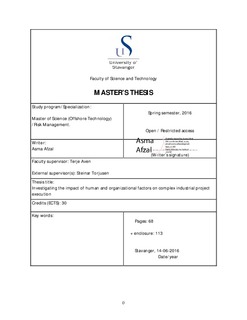| dc.description.abstract | Most of the projects letdowns are encountered in production industries such as oil and gas Production industries are attributed to human factors; at the same time repercussions related to such incompetence consistently expose industries to big challenges.
During the project delivery stages it has become increasingly important to look up into the Project success rates. A universal approach towards the success of delivering complex projects is by ascertaining well stated distinct requirements, assigning necessary resources, focusing on suitable design, appropriate project planning and management, beside a well enhanced team communication and coordination. Nevertheless, the consideration of all these preeminent practices does not guarantee success without risk factors because of the existence of the human ineffectiveness in a project like negligence, stress, incompetency, workload and poor social conduct in most cases resulting into likeliness of reduced effectiveness, quality as well as functionality, leading to delay in the deliverance of the project.
This study centralizes its attention on flaws and the initial cause of the faults encountered in between engineering and progression stage of project. Particularly, the background of the article restricted within Supervisory, Control and Data Acquisition (SCADA) systems and DCS (Distributed Control System) industrial control for vital infrastructures. SCADA and DCS systems are employed all through a wide range of industrial spheres including the power domain, in chemical plants, at gas and oil firms and distribution, the water and waste water domain, and others. A general feature about the utilization of the systems within the very industries so as the infrastructure operation and Control procedure is carried out all the way through various occurrences of multiple industrial control systems derived from a number of vendors, pooled into superior architectures of system inbuilt in other systems. All systems are worth being considered as vendor-generated products developed through a lengthy period for a wide range of consumers. Therefore, as soon as each system is vended and positioned, there is a great task through the engineering, product designing to the particulate operation condition at the same time incorporating in the midst of related neighboring systems.
Usually, during systems positioning a wide range of individuals from the vendors and EPC are included together with external experts.Thus, it is quite challenging to deliver this kind of a big and complicated project minding the three key inter-reliant constraints for each individual project: time, expense and scope. The delivery of projects within the stipulated budget and that successfully meet the scope requirements are not justified for being successful by the main stakeholders for quality issues.The study is aimed at exploring the sort of mistakes arising amid the development period of the SCADA and Industrial Control systems at the same time relating them to sort of liabilities the faults results into. This is done with an aspiration that the learning will be of significant help to the key decision makers and analysts at basic infrastructure operations and additionally system vendors to boost their productivity levels in accomplishing a high level of project management. The survey utilizes the Bayesian network so as to evaluate the relationship between positioning mistakes, and aspects,and their related impact on the project delivery. The information exhibited depends on interviews’ outcomes with specialists with long experience on SCADA system deployment as well as industrial control.
The proposition is an accumulation of exploratory papers, books, specialists’ judgment as well as outline contemplations on how Human ineffectiveness can impact on the project lifecycle.The key contributions (C) presented in the proposition are:
C1: Access of the qualitative structure of the Bayesian network (BN)
C2: Access to the quantitative parameters of the Bayesian network (BN)
C3: Quantification of the results and applicability of this replica
Throughout the study the following Research Questions (RQs) were discussed:
The findings will justify how these mistakes, in any project conveyance, is directly attributed to the human factors included. Furthermore, the most renowned causes of these kinds of mistakes will be identified in this research work. | nb_NO |
